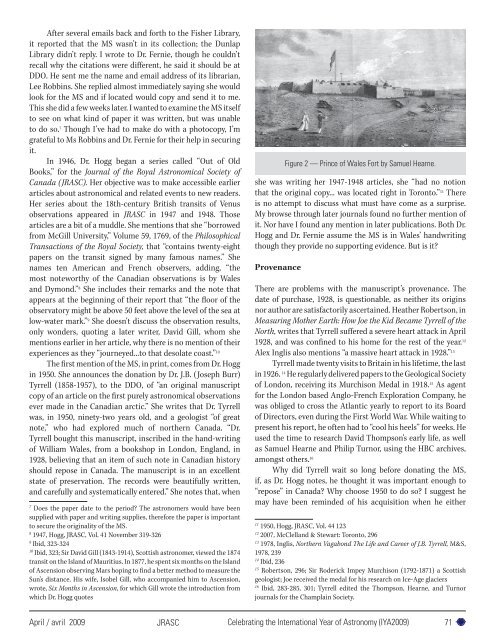Moment
insidethisissue - The Royal Astronomical Society of Canada
insidethisissue - The Royal Astronomical Society of Canada
You also want an ePaper? Increase the reach of your titles
YUMPU automatically turns print PDFs into web optimized ePapers that Google loves.
After several emails back and forth to the Fisher Library,it reported that the MS wasn’t in its collection; the DunlapLibrary didn’t reply. I wrote to Dr. Fernie, though he couldn’trecall why the citations were different, he said it should be atDDO. He sent me the name and email address of its librarian,Lee Robbins. She replied almost immediately saying she wouldlook for the MS and if located would copy and send it to me.This she did a few weeks later. I wanted to examine the MS itselfto see on what kind of paper it was written, but was unableto do so. 7 Though I’ve had to make do with a photocopy, I’mgrateful to Ms Robbins and Dr. Fernie for their help in securingit.In 1946, Dr. Hogg began a series called “Out of OldBooks,” for the Journal of the Royal Astronomical Society ofCanada (JRASC). Her objective was to make accessible earlierarticles about astronomical and related events to new readers.Her series about the 18th-century British transits of Venusobservations appeared in JRASC in 1947 and 1948. Thosearticles are a bit of a muddle. She mentions that she “borrowedfrom McGill University,” Volume 59, 1769, of the PhilosophicalTransactions of the Royal Society, that “contains twenty-eightpapers on the transit signed by many famous names.” Shenames ten American and French observers, adding, “themost noteworthy of the Canadian observations is by Walesand Dymond.” 8 She includes their remarks and the note thatappears at the beginning of their report that “the floor of theobservatory might be above 50 feet above the level of the sea atlow-water mark.” 9 She doesn’t discuss the observation results,only wonders, quoting a later writer, David Gill, whom shementions earlier in her article, why there is no mention of theirexperiences as they “journeyed...to that desolate coast.” 10The first mention of the MS, in print, comes from Dr. Hoggin 1950. She announces the donation by Dr. J.B. (Joseph Burr)Tyrrell (1858-1957), to the DDO, of “an original manuscriptcopy of an article on the first purely astronomical observationsever made in the Canadian arctic.” She writes that Dr. Tyrrellwas, in 1950, ninety-two years old, and a geologist “of greatnote,” who had explored much of northern Canada. “Dr.Tyrrell bought this manuscript, inscribed in the hand-writingof William Wales, from a bookshop in London, England, in1928, believing that an item of such note in Canadian historyshould repose in Canada. The manuscript is in an excellentstate of preservation. The records were beautifully written,and carefully and systematically entered.” She notes that, when7Does the paper date to the period? The astronomers would have beensupplied with paper and writing supplies, therefore the paper is importantto secure the originality of the MS.81947, Hogg, JRASC, Vol. 41 November 319-3269Ibid, 323-32410Ibid, 323; Sir David Gill (1843-1914), Scottish astronomer, viewed the 1874transit on the Island of Mauritius. In 1877, he spent six months on the Islandof Ascension observing Mars hoping to find a better method to measure theSun’s distance. His wife, Isobel Gill, who accompanied him to Ascension,wrote, Six Months in Ascension, for which Gill wrote the introduction fromwhich Dr. Hogg quotesshe was writing her 1947-1948 articles, she “had no notionthat the original copy... was located right in Toronto.” 11 Thereis no attempt to discuss what must have come as a surprise.My browse through later journals found no further mention ofit. Nor have I found any mention in later publications. Both Dr.Hogg and Dr. Fernie assume the MS is in Wales’ handwritingthough they provide no supporting evidence. But is it?ProvenanceFigure 2 — Prince of Wales Fort by Samuel Hearne.There are problems with the manuscript’s provenance. Thedate of purchase, 1928, is questionable, as neither its originsnor author are satisfactorily ascertained. Heather Robertson, inMeasuring Mother Earth: How Joe the Kid Became Tyrrell of theNorth, writes that Tyrrell suffered a severe heart attack in April1928, and was confined to his home for the rest of the year. 12Alex Inglis also mentions “a massive heart attack in 1928.” 13Tyrrell made twenty visits to Britain in his lifetime, the lastin 1926. 14 He regularly delivered papers to the Geological Societyof London, receiving its Murchison Medal in 1918. 15 As agentfor the London based Anglo-French Exploration Company, hewas obliged to cross the Atlantic yearly to report to its Boardof Directors, even during the First World War. While waiting topresent his report, he often had to “cool his heels” for weeks. Heused the time to research David Thompson’s early life, as wellas Samuel Hearne and Philip Turnor, using the HBC archives,amongst others. 16Why did Tyrrell wait so long before donating the MS,if, as Dr. Hogg notes, he thought it was important enough to“repose” in Canada? Why choose 1950 to do so? I suggest hemay have been reminded of his acquisition when he either111950, Hogg, JRASC, Vol. 44123122007, McClelland & Stewart: Toronto, 296131978, Inglis, Northern Vagabond The Life and Career of J.B. Tyrrell, M&S,1978, 23914Ibid, 23615Robertson, 296; Sir Roderick Impey Murchison (1792-1871) a Scottishgeologist; Joe received the medal for his research on Ice-Age glaciers16Ibid, 283-285, 301; Tyrrell edited the Thompson, Hearne, and Turnorjournals for the Champlain Society.April / avril 2009JRASCCelebrating the International Year of Astronomy (IYA2009)71
















